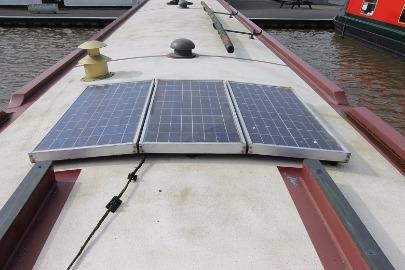Narrow boat Solar power
Solar photovoltaic (PV) systems are one of the many types of renewable energy available to us. We can use the sun's energy to operate solar panels to drive gadgets which can be used on a narrow boat, as well installing them on the roofs of our homes and businesses. They don't produce carbon dioxide (CO2) emissions or use up valuable fossil fuels.

Solar PV panels work very simply by converting light energy from the sun into electricity. It can even be a cloudy day and the panels don't even need to be positioned in direct sunlight. When fitted to our homes, PV can supply us with green energy and any surplus electricity produced can be returned back to the grid, known as ‘on-grid' systems. Or we can use ‘off-grid' systems, which store electrical power generated in batteries that can be used later when needed.
There are a number of specialist adapted solar PV panels that can be used both outdoors and indoors to power household gadgets such as mobiles, cameras, laptops, notebooks and to keep the batteries charged up.
However, the biggest challenge of specially designed solar panels is getting the right power output. Too little and you'll be half way through surfing the Internet for the following day's adventure and the power goes off; too much and you will have spent a fortune on something the capacity of which you'll use only a tiny proportion.

There are a number of advantages worth considering when it comes to solar energy and everything that it offers:
- It is a completely renewable resource
- Solar systems make absolutely no noise at all
- Solar energy creates absolutely no pollution so does not further damage the ozone layer
- Very little maintenance is required to keep solar panels
Choosing the correct solar panels for your boat
Solar panels have varing amounts of different output depending on: Construction, quality polycrystalline or Monocrystalline.
Power output, a single 100w high efficiency panel with Monocrystalline cells will produce circa 600-750Wh on a summer day.
Then we come to the controllers. there are 2 main types, PWM which means Pulse Width Modulation, and MPPT Maximum Power Point Tracking. With panel that have a higher voltage MPPT controllers are recommended. It is an advantage to fit a controller which has additional capacity, so more panels can be fitted at a later date if required.
Hope you find this article informative, and happy cruising from all the team at Venetian Marina.